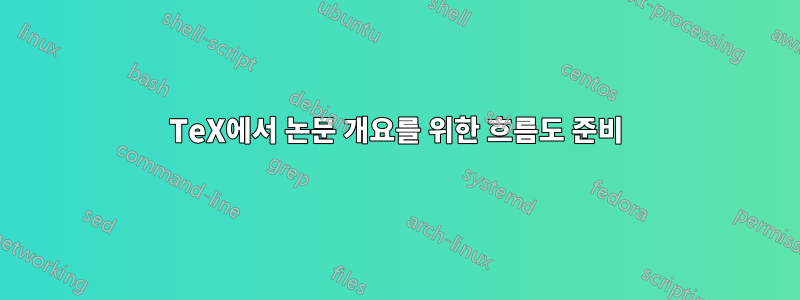
LaTeX로 논문 개요를 위한 흐름도를 준비하고 싶은데, 다음 그림과 같습니다. 다음 코드를 적용하려고 했는데 C, D, E를 배열하는 데 막혔습니다. 누군가 나를 도와줄 수 있는지 궁금합니다. 미리 감사드립니다!
편집됨:
\begin{figure}
\centering
\begin{tikzpicture}[node distance=1.5cm]
\node (introduction) [structure] {Thesis};
\node (methodology) [structure, below =1.5cm of introduction] {A};
\node (theoretical) [structure, below =1.5cm of methodology] {B};
\node (model) [structure, below of=theoretical] {C};
\node (interviews) [structure, below of=model] {D};
\node (results) [structure, below of=interviews] {E};
\node (discussion) [structure, below =of results] {F};
%arrows
\draw [arrow] (introduction) -- (methodology);
\draw [arrow] (methodology) -- (theoretical);
\draw [arrow] (theoretical) -- (model);
\draw [arrow] (model) -- (interviews);
\draw [arrow] (interviews) -- (results);
\draw [arrow] (results) -- (discussion);
\end{tikzpicture}
\caption{OUTLINE}
\end{figure}
%%%%%%%%%%%%%%%%%%%%%%%
답변1
너비는 B매우 수동적이지만 이 간단한 예에서는 그다지 복잡하지 않습니다.
암호
\documentclass[tikz]{standalone}
\usetikzlibrary{arrows.meta, chains, ext.paths.ortho}
\begin{document}
\begin{tikzpicture}[
node distance = 10mm and 5mm,
box/.style = {
rectangle, draw, font=\strut, minimum width=25mm, minimum height=10mm},
boxie/.style = {box, minimum width=15mm},
arr/.style = -Triangle,
start chain = ch going below, every join/.append style=arr]
\node[box, on chain] {Thesis};
\node[box, on chain, join] {A};
\node[box, on chain, join, minimum width = 3*15mm + 2*5mm + 2\pgflinewidth] {B};
\node[boxie, on chain, join] {D};
\scoped[start branch=left going base left]
\node[boxie, on chain, join=with ch-3 by only vertical second]{C};
\scoped[start branch=right going base right]
\node[boxie, on chain, join=with ch-3 by only vertical second]{E};
\node[box, on chain, join,
join=with ch/left-end by vertical horizontal,
join=with ch/right-end by vertical horizontal] {F};
\end{tikzpicture}
\end{document}
산출
답변2
흠, 왠지 구문이 잘못된 것 같습니다. 그래서 나는 코드를 고치는 대신 LaTeX에서 그 중 일부와 선택 사항을 보여 주기로 결정했습니다. 기본 주제:
- 최소한 절대 좌표를 통해 첫 번째 메모의 위치를 지정하세요.
- 이 예에서는 2번째도 절대 좌표로 배치했습니다.
below여기서는 ,left및 를 통해 상대 위치 지정을 사용하는 것이 더 편리합니다.right- 방법론에 따라 화살표를 약간 변경했습니다.
- 당신은 Th.c처럼 그들 모두를 할 수 있고 그것은 괜찮아 보일 것입니다
- Th.d에는 다른 연결 지점이 표시됩니다. 절대 좌표로 이동할 수도 있습니다
- Th.c to Results는 스케치를 모방합니다.
- 다른 쪽에서는 벤드가 이렇게 보일 수 있습니다
따라서 아직 수행하지 않으셨다면 다음에서 최소한의 소개에 시간을 투자하시기 바랍니다.https://www.ctan.org/pkg/pgf.

\documentclass[10pt,border=3mm]{standalone}
\usepackage{tikz}
\usetikzlibrary{positioning}% needed for relative positioning
\begin{document}
% demonstarting some choices
\tikz{
% ~~~ nodes ~~~~~~~~~~~~~~~~~~~~~~~~~~~~~~~~~~~~~
% absolute coordinates
\node [draw] (T) at (0,0) {Thesis};% [draw] will draw the box around the node
\node [draw] (A) at (0, -1) {Introduction};
% relative coordinates from now on
\node [draw] (B) [below=of A] {Methodology};
\node [draw] (D) [below=of B] {Theoretical d};
\node [draw] (C) [left=of D] {Theoretical c};
\node [draw] (E) [right=of D] {Theoretical e};
\node [draw] (F) [below=of D] {Results};
% ~~~ arrows ~~~~~~~~~~~~~~~~~~~~~~~~~~~~~~~
\draw [->] (T) -- (A);% straight
\draw [->] (A) -- (B);
\draw [->] (B) -- (D);
\draw [->] (D) -- (F);
\draw [->] (B) -- (C);
\draw [->] (B.east) -- (E.north east);
\draw [->] (C) |- (F);% first down, then horizontally
\draw [->] (E) to [bend left] (F);
}
\end{document}
답변3
나는 출발점이 될 수 있는 것을 만들었습니다. 실제 마법사가 해결하는 방법은 아닐 수도 있지만 작동합니다.
서문에서 다음과 같은 내용을 작성해야했습니다.
\usetikzlibrary{positioning,shapes,shadows,arrows,calc,arrows.meta}
\tikzstyle{structure} = [rectangle, minimum width=3cm, minimum height=1cm, align=center, text width=2.5cm, draw=black, very thick]
\tikzstyle{arrow}=[-,ultra thick,{-Stealth[]}]
이러한 정의를 사용하여 다음 코드는 사용자의 것과 다소 유사한 그림을 생성합니다.
\begin{tikzpicture}[node distance=1.5cm]
\node (introduction) [structure] {Thesis};
\node (methodology) [structure, below of=introduction, yshift=-0.5cm] {A};
\node (theoretical) [structure, below of=methodology, yshift=-0.5cm] {B};
\node (model) [structure, below of=theoretical, xshift=-4cm, yshift=-0.5cm] {C};
\node (interviews) [structure, right of=model, xshift=2.5cm] {D};
\node (results) [structure, right of=interviews, xshift=3cm] {E};
\node (discussion) [structure, below of=interviews, yshift=(-0.5cm)] {F};
%lines
\draw [arrow] (introduction.south) -- (methodology.north);
\draw [arrow] (methodology.south) -- (theoretical.north);
\draw [arrow] ($(theoretical.south west)!.3!(theoretical.south)$) -- ++(0.0,-0.5) -| (model.north);
\draw [arrow] (theoretical.south) -- ++(0,-0.5) -| (interviews.north);
\draw [arrow] ($(theoretical.south)!.7!(theoretical.south east)$) -- ++(0.0,-0.5) -| (results.north);
\draw [arrow] (model.east) -- (interviews.west);
\draw [arrow] (interviews.east) -- (results.west);
\draw [arrow] (model.south) -- ++(0.0,-0.5)-| ($(discussion.north west)!.3!(discussion.north)$);
\draw [arrow] (interviews) -- ++(0,-1) -| (discussion);
\draw [arrow] (results) -- ++(0,-1) -| ($(discussion.north)!.7!(discussion.north east)$);
\end{tikzpicture}




